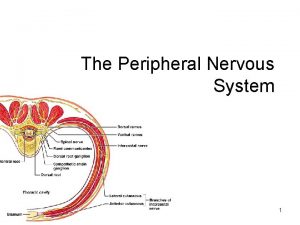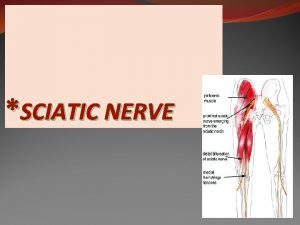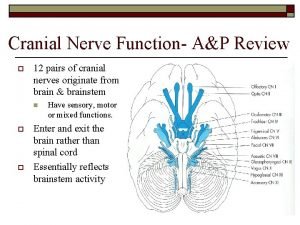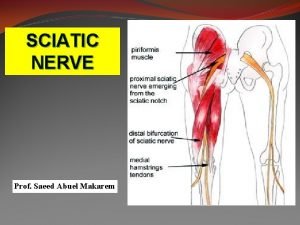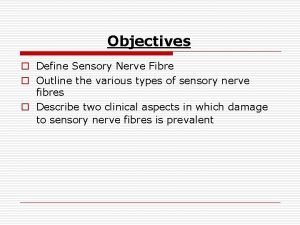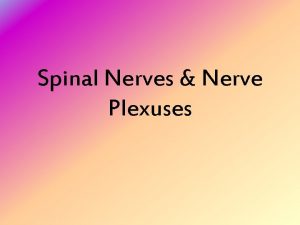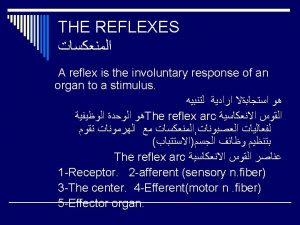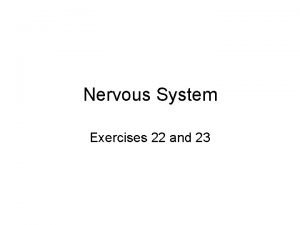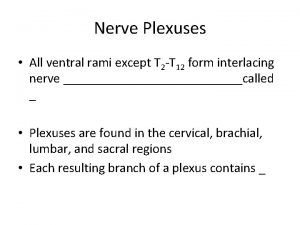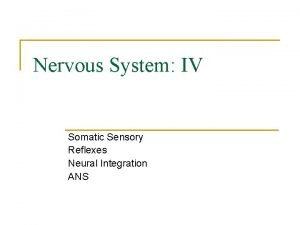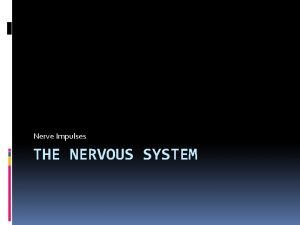The Nervous System Nerve Plexuses Reflexes and Sensory












- Slides: 12

The Nervous System: Nerve Plexuses, Reflexes, and Sensory and Motor Pathways. By: Avi Asraf Roger Yee Santiago Roybal Sasha Buz Valeria Muňoz Vincent Cottrill

Nerve Plexuses • Cervical plexus – innervates the muscles of the neck and extends into the thoracic cavity to control the diaphragm. • Brachial plexus – innervates the shoulder girdle and upper limb • Lumbar plexus & Sacral plexus – supply the pelvic girdle and lower limb. ▫ *all designate the lumbosacral plexus.

Reflexes • A reflex is an automatic motor response to a specific stimulus. • A reflex response usually removes or opposes the original stimulus. • Reflexes help maintain homeostasis by making rapid adjustments to the functions of organs/ organ systems. • Reflex arcs are an example of negative • feedback.

Simple Reflex • The “wiring” of a single reflex is called a reflex arc.

Simple Reflex • In the simplest reflex arc, a sensory neuron synapses directly on a motor neuron, which performs information processing function. This is also known as a monosynaptic reflex. • The sensory receptors in the stretch reflex are called muscle spindles.

Simple Reflex • Stretch reflexes are important in maintaining normal posture and balance and in making automatic adjustments in muscle tone. • Doctors can use the sensitivity of the stretch reflex to test general conditions of the spinal cord, peripheral nerves, and muscles. • Example: knee jerk reflex

Complex Reflexes • Polysyanptic reflexes include a longer delay between stimulus and response. • They can produce more involved responses because the interneurons can control several muscle groups simultaneously. • Withdrawal reflexes move stimulated parts of the body away from a source of stimulation. • The strongest withdrawal reflexes are caused by pain stimuli. • A flexor reflex is a withdrawal reflex affecting the muscles of a limb.

Complex Reflexes • When a specific muscle contracts, opposing muscles are stretched. • Contraction of a flexor muscles should trigger in the extensors a stretch reflex that would cause them to contract, opposing the movement that is underway. • Interneurons in the spinal cord prevent such competitions through reciprocal inhibition.

Integration and Control of Spinal Reflexes • Although reflexes are automatic, higher centers in the brain influence these response by stimulating or inhibiting the interneurons and motor neurons involved. • Stroking the side of an infants sole produces a fanning of toes known as the Babinski sign/positive Babinski reflex. • In adults, the toes curl, which is called Plantar reflex/negative Babinski reflex.

Sensory and Motor Pathways Sensory Pathways • A sensation, the information gathered by a sensory receptor, arrives in the form of action potentials in an afferent (sensory) fiber. ▫ Posterior Column Pathway is an example of an ascending sensory pathway. The pathway of messages sent from the brain to the phalanges.

Sensory and Motor Pathways • The corticospinal pathway/pyramidal system provides conscious, voluntary control of skeletal muscles. • The medial and lateral pathways provide subconscious, involuntary control of muscle tone and movements of the neck, trunk, and limbs. ▫ These pathways were known as the extrapyramidal system because it was thought that they operated independently of and parallel to the pyramidal system. ▫ The corticospinal pathway begins at pyramidal cells of the cerebral cortex.

Quick Review • 1) What is another name for the simplest reflex arc? • 2) Why are stretch reflexes important? • 3) What is the difference between the positive Babinski reflex and the negative Babinski reflex? • 4) What is a sensation? • 5) Where do corticospinal pathways begin?
 Peripheral nerves and nerve plexuses
Peripheral nerves and nerve plexuses Identify each type of neuronal pool
Identify each type of neuronal pool Nervous
Nervous Processes neuron
Processes neuron Lumbar spine nerve roots
Lumbar spine nerve roots Motor and sensory nerve
Motor and sensory nerve Sciatic nerve sensory distribution
Sciatic nerve sensory distribution Smiling cranial nerve
Smiling cranial nerve Common peroneal nerve injury
Common peroneal nerve injury Sensory nerve types
Sensory nerve types Nervous system and digestive system
Nervous system and digestive system Adh function
Adh function Endocrine system and nervous system
Endocrine system and nervous system
